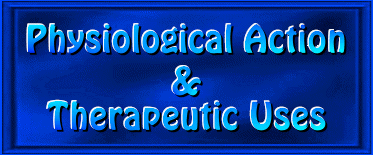

The following is excerpted from The Professional's Herbal Formula Handbook No. 8, comprising 81 pages of traditional information and recent scientific data that describes the medical properties, physiological action and therapeutic uses for each of the 24 ingredients outlined in this formula.




Adaptogenic, alterative, anabolic, antibiotic, anti-cachexic, anti-dyscratic, anti-fatigue, anti-infective, antioxidant, antiphlogistic (anti-inflammatory), antiseptic, anti-sclerotic, anti-stress, anti-thrombotic, bacteriostatic (anti-bacterial), biocatalyst, calmative, cardiotonic, cell proliferant, cytophylactic, cytotoxic, decongestant, deobstruent, depurative, detoxicant, disinfectant, diuretic, estrogenic, hemodynamic, hormonagogue, hypotensive, microbicidal (anti-microbial), relaxant, rejuvenative, restorative, stimulant (circulatory and secretolytic), tonic, vasodilator and vasotonic.


Alleviates any general fluids dyscrasia
(abnormal or pathological condition) within the blood vessels and
tissue-systems throughout the circulatory and cardiovascular
systems while regulating any general blood dyscrasia by purely
qualitative means through the altering of any injurious
processes, and eliminates any form of cachexia (state of
malnourishment and general debility) associated with
arteriosclerosis (arterial hardening) or atherosclerosis and
hypercholesterolemia (excessive cholesterol formation); relieves
any hypertension or congestion by reducing the total serum
cholesterol, triglyceride, fatty acid and low density lipoprotein
(LDL) levels while increasing serum high density lipoprotein
(HDL) cholesterol levels (which inhibits the formation of
atherosclerosis) in those conditions involving hyperlipidemia
(elevated lipids or fats in the blood), which is accomplished
through the mechanism of accelerated degradation, conversion and
excretion of cholesterol and triglycerides; promotes increased
cholesterol and lipid metabolism by increasing the synthesis of
cholesterol in the liver, and enhances greater synthesis of
cholesterol by accelerating its decomposition or breakdown into
other steroids (which provides increased protection against the
formation of atherosclerotic disease); exhibits anti-thrombotic
activity in order to prevent blood platelet aggregation or blood
clotting by inhibiting any further exposure of the fibrinogen
receptors located on platelet membranes, thereby enhancing
greater overall effectiveness against the onset of
atherosclerosis; displays hypotensive effects upon the
cardiovascular system in order to reduce any abnormally high
arterial pressure, and exhibits regulatory activity in order to
normalize those conditions involving high blood pressure
associated with excessive cholesterol, triglyceride and fatty
acid formation; provides direct hemodynamic activity throughout
the entire cardiovascular system accompanied by an increase in
the force of cardiac contraction, especially during any acute
circulatory failure or dysfunction; promotes increased tonicity
throughout the heart, arteries, veins and capillaries while
promoting increased capillary circulation, and generates greater
protective effects against any oxygen deficiency damage to the
heart muscle (due to the presence of ginsenosides Rb and Ro)
caused by lipid peroxidation; enhances greater endocrine activity
(due to the presence of panaquilon), and alleviates any adrenal
insufficiency by inhibiting the development of adrenal atrophy or
hypertrophy; enhances the overall functional capabilities of the
endocrine glands, particulary the adrenal cortex (which produces
hormonal secretions in order to regulate the proper metabolism of
fats or lipids); stimulates the adrenal cortex, which produces an
increased corticosteroid content in the urine and a decrease in
the eosinophil cell count; acts predominantly upon the
hypothalamus and pituitary glands by promoting the secretion of
the adrenocorticotrophic hormone (ACTH) and related pituitary
substances (e.g., beta-lipoprotein, endorphins, enkephalins,
etc.) in order to enhance the manufacture and secretion of
adrenal hormones, and exhibits a balancing effect upon the
hypothalamic-pituitary-adrenal axis by adjusting the metabolic
and functional systems that govern hormonal control of
homeostasis; acts directly upon the peripheral site of the stress
mechanism (the adrenal glands) as opposed to a central cerebral
site (the hypothalamic or pituitary activity), which facilitates
a more efficient and regulated output of adrenaline in order to
better mobilize the body's reserves (especially in the
musculature and connective tissues); possesses a complete mixture
of triterpenoid sapogenins (panaxosides, ginsenosides and the
chiku-setsusaponins) and steroidal glycosides (acetal derivatives
of sugar) that include (1) panaxinol or panaxin (which stimulates
the cerebellum (or midbrain), heart and blood vessels), (2)
panaxic acid (which energizes the heart and the metabolic
processes), (3) panaquilin (which activates all the internal
secretions), (4) panacene (which stimulates the central nervous
system), and (5) ginsenin (which displays hypoglycemic activity
by lowering blood sugar levels); possesses ginsenosides
(water-soluble polysaccharides) that increase the levels of
superoxide dismutase (SOD) in the heart muscle, and tonifies the
heart in order to increase the contractive capabilities of the
heart muscle; restores normal adrenal function, and provides
greater elasticity or resilience to the functional capabilities
of the entire organism; possesses mitogenetic radiations that
effectively stimulate the chain of endocrine glands, thereby
increasing their overall hormone-producing capabilities; emits
organic radioactive rays in order to stimulate the vital
processes in the cellular tissues, and enhances the breakdown of
fatty acids into energy during prolonged exercise; exhibits
cytophylactic and cytotoxic effects in order to increase cellular
defense against any infection or infectious conditions, and
displays significantly increased resistance towards any stressful
conditions (particularly throughout the entire capillary system);
displays bacteriostatic activity in order to arrest the growth of
harmful pathogenic bacteria, as well as natural antibiotic
properties in order to prevent the growth of certain microbes;
exhibits bacteriostatic and microbicidal activity in order to
strengthen and increase the resistance of the blood vessels
against any invasive or harmful pathogenic bacteria or microbes
throughout the arteries, veins and capillaries, as well as to
inhibit the further development of any inflammatory or infectious
conditions throughout the entire cardiovascular or circulatory
systems; displays significant antiphlogistic activity in order to
inhibit the formation of certain inflammatory compounds (such as
histamine, leukotrienes, prostaglandin, serine proteases and
thromboxanes), as well as to reduce any severe inflammatory
swelling by exerting an extremely positive influence towards
correcting any blood vessel or tissue inflammation and various
other internal inflammatory conditions; demonstrates significant
antiseptic effects by destroying the vitality of any organized
living ferments in order to prevent the onset of putrefaction or
septicemia, and precipitates the proteins in any inflamed tissues
in order to provide a mildly antiseptic and protective coating
(under which the regeneration of new tissue occurs) for the blood
vessels and tissue-systems throughout the entire cardiovascular
and circulatory systems; acts as an effective antiseptic in order
to remove any septic conditions associated with tissue
degeneration or ulceration, and promotes increased suppuration
and a steady toning or restorative impression to the entire
glandular system (especially the liver and lymph glands);
displays biocatalytic activity in order to enhance greater
assimilation of those essential nutrients that are necessary for
the increased production of energy and vitality, thereby
accelerating certain rejuvenative processes associated with the
repair of any damaged blood vessels or tissue-systems throughout
the entire organism; acts as a biocatalyst in order to accelerate
and accentuate the transport of all the other herbal ingredients
throughout the entire organism to specific areas of the body
(especially the blood vessels and cardiovascular system), and
exhibits circulatory stimulant activity in order to permeate the
entire organism (both internally and externally) with greater
warmth and movement by supporting the innate warmth that resides
in the blood and tissue-systems; acts as a cell proliferant in
order to stimulate increased cellular mitosis (cell division and
reproduction) in an adequate nutritional environment, as well as
to accelerate the healing processes by promoting increased
granulation and greater resolution during the repair of any
damaged blood vessels or tissue-systems; displays cell
proliferant activity in order to inhibit the normal aging process
within the blood vessels or tissue-systems, thereby extending the
overall lifespan of the various cells and tissues throughout the
entire organism; exhibits anabolic activity in order to
accelerate the production of DNA and RNA (which enhances the
production of proteins in the form of antibodies), while
increasing protein and lipid synthesis in the bone marrow and
DNA/RNA content in the adrenals and lymph nodes (along with
increased body weight and enhanced re-synthesis of glycogen and
high-energy phosphate compounds); demonstrates powerful
adaptogenic (balancing and strengthening) activity in order to
increase the overall resistance of an organism towards any
adverse influences or stressful conditions (whether they be
physical, chemical or biological in nature), especially upon the
blood vessels, musculature, immune system, and both the central
(cerebro-spinal centers) and peripheral nervous systems; acts as
a secretolytic stimulant in order to promote increased gastric,
pancreatic or intestinal secretory and motor activity, and
enhances greater peripheral circulation (due to its antioxidant
activity); exhibits significant antioxidant effects in order to
provide greater oxygen-transport capabilities throughout the
bloodstream, as well as enhance the transport of additional
oxygen directly into the cells and tissue-systems throughout the
blood vessels of the circulatory and cardiovascular systems; acts
as a circulatory stimulant by increasing the blood flows through
the arteries and blood vessels in order to enhance greater
nutrient transport, absorption and utilization, thereby
accelerating the healing processes associated with the repair of
any damaged tissue-systems throughout the entire organism; acts
as an effective nutritive and rejuvenative tonic to the
bloodstream and tissue-systems during convalescence (due to the
presence of rich sources of biotin, carbohydrates, choline,
chromium, copper, manganese, pantothenic acid, potassium,
protein, sulfur and vitamins B1, B2 and E) in order to enrich, nourish
and replenish any nutritional deficiencies or insufficiency
within the cells or tissues throughout the blood vessels or
musculature, which leads to the development of various
degenerative or atonic conditions throughout these areas of the
body; demonstrates significant rejuvenative and restorative
properties upon the basic plasma tissue-systems throughout the
entire organism, thereby enhancing the production of vital bodily
fluids while providing greater enrichment through increased
assimilation of the various organic mineral salts; accelerates
the recuperative processes that are essential in order to
overcome any chronic degenerative or debilitative illnesses,
while facilitating greater recovery response during convalescence
in order to fully regain optimal health and well-being; activates
the bodily processes of detoxification and elimination in order
to cleanse and purify the bloodstream and tissue-systems, and
acts as an eliminative vasotonic to the blood, liver and splenic
functions (as well as upon the eliminative functions of the
lymphatic system); enhances the overall cleansing process by
dilating the surface capillaries in order to more effectively
remove any toxic debris or other metabolic waste materials
through the pores of the skin; increases the secretion and
elimination of urine in order to provide further support to the
inner cleansing process; displays alterative activity in order to
correct any disordered bodily function, thereby activating
increased alterations in both metabolic and tissue functions as a
defensive measure against the onset of acute or chronic disease;
exhibits restorative effects in order to regain increased vigor
or vitality and greater strength, while enhancing normal tissue
and metabolic functional capabilities; demonstrates alterative
and restorative properties in order to re-establish healthy
systemic functional capabilities, as well as to establish greater
vascular tone throughout the entire organism (due to its ability
to stimulate increased secretory flows); exhibits alterative
effects in order to stimulate the anabolic growth processes,
thereby enhancing the repair of any degenerated, deteriorated or
debilitated cells or tissues (while promoting the elimination of
any catabolic waste materials); displays tonifying effects in
order to permanently enhance the overall energy-levels throughout
the entire organism, without adversely affecting the functional
capabilities of any particular organ or system.
![]()
None.
![]()